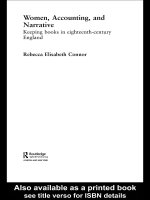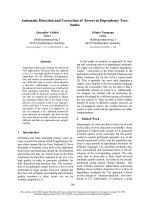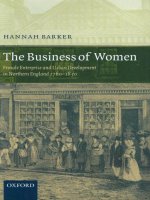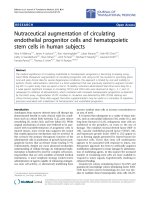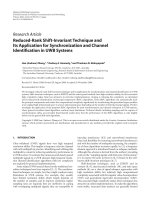Women, Accounting, and Narrative: Keeping books in eighteenth-century England potx
Bạn đang xem bản rút gọn của tài liệu. Xem và tải ngay bản đầy đủ của tài liệu tại đây (7.93 MB, 225 trang )
Women, Accounting, and
Narrative
In the early eighteenth century, the household accountant was tradition-
ally female. However, just as women were seen as financial accountants,
they were also deeply associated with the literary and narrative accounting
inherent in letters and diaries. This book examines these socio-linguistic
acts of feminized accounting alongside property, originality, and the
development of the early novel.
The book begins with an investigation of the reconceptualization of
value that occurred between the late seventeenth and early eighteenth
centuries. While women were often denied inheritance of land, their
fortunes were increasingly realized in moveable wealth: textiles, furniture,
plate, jewelry, and money. The value of such items necessarily required
documentation in the form of accounts, yet accounts did more than keep
track of possessions. The author shows how numbers were used to record
experience and create subjectivity, becoming a means of defining the self.
The century’s near-obsession with keeping books can be seen in women’s
almanac-diaries – where owners documented everything from sociability
to thrift – and also extended to literature.
Two female-narrated novels – Aphra Behn’s Fair Jilt and Daniel Defoe’s
Moll Flanders – are then examined, questioning the way in which the
century’s preoccupation with accounting manifested itself differently in
novels of the time. The book concludes with an examination of the devel-
oping relationship between property, narrative, and “personality.” The
picaresque, an older form of narrative which charts the search for real
property or land, is contrasted with the “novel of personality,” which
charts the search for personal property, or money.
The relationship of doubly accounting women to contemporary con-
ceptions of selfhood, prosperity, and the developing novel, is the subject
of this penetrating study.
This book will be essential reading for students and researchers of
history, economic history, women’s studies, and those interested in the
early novel.
Rebecca Elisabeth Connor was born in England and received her Ph.D.
from Stanford University. She is an Assistant Professor of English at Hunter
College in New York City.
1111
2
3
4
5
6
7
8
9
1011
1
2
3111
4
5
6
7
8
9
20111
1
2
3
4
5111
6
7
8
9
30111
1
2
3
4
5
6
7
8
9
40111
1
2
3
4
45111
Routledge Research in Gender and History
1 The Women’s Movement and Women’s Employment in
Nineteenth-Century Britain
Ellen Jordan
2 Gender, Sexuality and Colonial Modernities
Edited by Antoinette Burton
3 Women’s Suffrage in the British Empire
Citizenship, nation and race
Edited by Ian Christopher Fletcher, Laura E. Nym
Mayhall and Philippa Levine
4 Women, Educational Policy-Making and Administration
in England
Authoritative women since 1800
Edited by Joyce Goodman and Sylvia Harrop
5 Women, Gender and Labour Migration
Historical and global perspectives
Edited by Pamela Sharpe
6 Women, Accounting, and Narrative
Keeping books in eighteenth-century England
Rebecca Elisabeth Connor
1111
2
3
4
5
6
7
8
9
1011
1
2
3111
4
5
6
7
8
9
20111
1
2
3
4
5
6
7
8
9
30111
1
2
3
4
5
6
7
8
9
40111
1
2
3
4
45111
Women, Accounting, and
Narrative
Keeping books in eighteenth-century
England
Rebecca Elisabeth Connor
1111
2
3
4
5
6
7
8
9
1011
1
2
3111
4
5
6
7
8
9
20111
1
2
3
4
5111
6
7
8
9
30111
1
2
3
4
5
6
7
8
9
40111
1
2
3
4
45111
For my mother
First published 2004
by Routledge
29 West 35th Street, New York, NY 10001
Simultaneously published in the UK
by Routledge
11 New Fetter Lane, London EC4P 4EE
Routledge is an imprint of the Taylor & Francis Group
© 2004 Rebecca Elisabeth Connor
All rights reserved. No part of this book may be reprinted
or reproduced or utilized in any form or by any electronic,
mechanical, or other means, now known or hereafter invented,
including photocopying and recording, or in any information
storage or retrieval system, without permission in writing
from the publishers.
Library of Congress Cataloging in Publication Data
A catalog record for this book has been requested
British Library Cataloguing in Publication Data
A catalogue record for this book is available from the
British Library
ISBN 0–415–17046–X
1111
2
3
4
5
6
7
8
9
1011
1
2
3111
4
5
6
7
8
9
20111
1
2
3
4
5
6
7
8
9
30111
1
2
3
4
5
6
7
8
9
40111
1
2
3
4
45111
This edition published in the Taylor & Francis e-Library, 2004.
ISBN 0-203-64603-7 Master e-book ISBN
ISBN 0-203-67384-0 (Adobe eReader Format)
(Print Edition)
Contents
List of illustrations vii
Acknowledgments ix
Introduction 2
1 Diary of a not-so-mad housewife 5
The consumer ethic – or ethical consumption 17
Accounting for women 19
Money as metaphor – and mind your own business 24
The power of portability 28
Accounting for accounting 29
Accounting for texts 33
From fiction to finance to faction 34
The me generation: memorandum, memory, memoir 40
Just what the doctor ordered 43
A no-good account 45
Accounts personified 46
Ladies do the math 51
Widow-take-all 57
Accentuate the masculine/eliminate the feminine 59
The mathematics of morality 63
Woman as micromanager 64
The perils of lady in the dark 65
2 Jack and The Fair Jilt: the value of Aphra Behn 67
Demise of a specie 67
The bent of Behn 68
In for a pistole, in for a pound 75
All’s fair/fair is all 76
A fair exchange 78
Coin of the realms 84
Giving The Fair Jilt a fair shake 89
1111
2
3
4
5
6
7
8
9
1011
1
2
3111
4
5
6
7
8
9
20111
1
2
3
4
5111
6
7
8
9
30111
1
2
3
4
5
6
7
8
9
40111
1
2
3
4
45111
3 Birds of a different feather: going toe-to-toe with Defoe 91
Jailbirds, but not together 92
The root of the root of all evil 93
The flip side of clipping 99
Social accounting: reading and writing arithmetick 101
You’re nobody till somebody owes you 106
Now you see it/now you don’t 107
You are what you count 108
Of haggling and the body prix fixe 111
Delivery à la carte 112
Moll of America 116
Friends of Flanders 116
The calico caper 119
Going broke and breaking back 120
Deconstructing Defoe 124
4 He said/she said: from the picaresque to the pointedly
personal 127
Pick a peck of picaresques 128
Land of the free(holders) 130
She’s got personality 132
And she’s got funds 134
She’s got good and plenty 136
And she’s got it all 137
The I of the narrator/the He of the well-born hunk 142
On an ego trip with the girls 145
Property rights and wrongs 149
The movers and the shirkers 150
Coming full-circle to the ladies who count 151
Notes 153
References 194
Index 206
1111
2
3
4
5
6
7
8
9
1011
1
2
3111
4
5
6
7
8
9
20111
1
2
3
4
5
6
7
8
9
30111
1
2
3
4
5
6
7
8
9
40111
1
2
3
4
45111
vi Contents
Illustrations
Inside front cover to The Ladies’ Own Memorandum (1775), with
handwritten entries.
From the copy in the Rare Book Collection, Burke
Library, Hamilton College. Reproduced here with permission.
1
1–7 Diary pages from The Ladies’ Own Memorandum (1775).
From the copy in the Rare Book Collection, Burke Library,
Hamilton College. Reproduced here with permission.
4–13
8 Printed page from The Ladies’ Own Memorandum (1775).
From the copy in The Rare Book Collection, Burke Library,
Hamilton College. Reproduced here with permission.
27
9 Exterior view of The Ladies’ Own Memorandum (1775),
with tie.
From the copy in The Rare Book Collection, Burke
Library, Hamilton College. Reproduced here with permission.
28
10 Page from John Vernon’s The Compleat Comptinghouse
(1709 edition).
By permission of the Goldsmiths’ Library of
Economic Literature, University of London Library.
38
11 From Charles Vyse’s Young Ladies Accountant, and Best
Accomplisher (1771).
From the copy in the Historical
Textbooks Collection, Monroe C. Gutman Library Special
Collections, Harvard Graduate School of Education. Reproduced
here with permission.
52
12 Title page, Advice to the women and maidens of London
(1708 edition).
By permission of the University of Chicago
Library, Special Collections Research Center.
58
13–14 Sample accounts (including double-entry) from Advice
to the women and maidens of London (1708 edition).
By permission of the University of Chicago Library, Special
Collections Research Center.
60–1
1111
2
3
4
5
6
7
8
9
1011
1
2
3111
4
5
6
7
8
9
20111
1
2
3
4
5111
6
7
8
9
30111
1
2
3
4
5
6
7
8
9
40111
1
2
3
4
45111
15 From Mathew Quin’s The Rudiments of Book-keeping
(1777).
By permission of the Irish Pamphlet Collection,
Rare Book Department, The Free Library of Philadelphia.
62
16 Aphra Behn, handwritten letters dated 1668 (PRO 29/170,
no. 88; PRO 29/151, no. 126).
By permission of the Public
Record Office, Kew, England.
72
17 From Daniel Defoe’s Moll Flanders, 1722 edition.
By permission of the University of Chicago Library, Special
Collections Research Center.
113
18 From Robert Chamberlain’s The Accomptants Guide, or
Merchants Book-keeper (1696). By permission of The
Annenberg Rare Book and Manuscript Library, University of
Pennsylvania.
115
19 Pages from Richard Latham’s account book (1751).
By permission of the County Archivist, Lancashire Record Office. 152
1111
2
3
4
5
6
7
8
9
1011
1
2
3111
4
5
6
7
8
9
20111
1
2
3
4
5
6
7
8
9
30111
1
2
3
4
5
6
7
8
9
40111
1
2
3
4
45111
viii Illustrations
Acknowledgments
This work on accounting has incurred many debts. I would like to thank
Terry Castle for knowing what was interesting about this project when I
didn’t, for her sustaining encouragement, and for insisting that academic
writing be lucid and accessible. John Bender’s ambitions for me far
exceeded my own; this is a more complicated and better reasoned piece
of scholarship because of his high standards and close attention. My
interest in the peculiarities of eighteenth-centry accounting began in Jay
Fliegelman’s class; I thank him for his provocative questions, his enormous
intellectual generosity, and for emboldening my imagination. I would like
to thank the University of Chicago, for use of their library facilities. I am
also indebted to the anonymous readers at Studies in Eighteenth-Century
Culture, for thoughtful comments on Chapter 3, and to their editorial
board, for permission to reprint a section of that chapter. Robert Nathan’s
steadfastness helped me through the early stages of this project. Marianita
Amodio’s skill and perfectionism are responsible for many of the photo-
graphic images; I am also grateful to Myra Appleton and Donna Gregory
for their thorough and intelligent editing. I would like to thank my father
for his unwavering interest and enthusiasm. Finally, without the kindness,
quick wit, and encouragement of Tony Gould, I would not have finished
this book.
1111
2
3
4
5
6
7
8
9
1011
1
2
3111
4
5
6
7
8
9
20111
1
2
3
4
5111
6
7
8
9
30111
1
2
3
4
5
6
7
8
9
40111
1
2
3
4
45111
1111
2
3
4
5
6
7
8
9
1011
1
2
3111
4
5
6
7
8
9
20111
1
2
3
4
5
6
7
8
9
30111
1
2
3
4
5
6
7
8
9
40111
1
2
3
4
45111
1111
2
3
4
5
6
7
8
9
1011
1
2
3111
4
5
6
7
8
9
20111
1
2
3
4
5111
6
7
8
9
30111
1
2
3
4
5
6
7
8
9
40111
1
2
3
4
45111
Inside front cover to The Ladies’ Own Memorandum (1775), with handwritten entries
Source: From the copy in the Rare Book Collection, Burke Library, Hamilton College. Reproduced here with permission.
Introduction
The words that recur in the literature of an age offer clues to contem-
porary fascinations and anxieties. In the eighteenth century, “account” is
such a word, taking various forms and conveying multiple meanings.
Account, accounting, accountable: the words are found everywhere from
tutelary texts to novels, particularly – it turns out – in literature about
and directed toward women. In eighteenth-century usage, “account”
denoted supposedly true histories as well as fictitious chronicles, encom-
passed simple financial sums as well as complex double-entry bookkeeping,
described Protestant debt–credit relationships to God as well as social
ties exacting in their reciprocal economic responsibility. “Account” speaks,
too, of memory – what is chosen to be remembered, and how people
remember. What then, are the cultural and ideological preoccupations
behind these literary references, and why are they so often associated with
women?
This book explores works of fiction alongside the various ladies’
almanacs and pocket books ubiquitous in the eighteenth century. These
portable volumes often included blank “chapters” intended as diaries, to
be kept by women primarily for the recording of financial accounts. Indeed,
such volumes express a growing cultural expectation that women document
what they had, what they owed, and what they were owed. I shall exam-
ine a pattern of behavior displayed not only by ordinary women diarists,
but also by women characters in popular novels of the era, many of whom,
like the heroines of Defoe and Richardson, seem to be fictional versions of
the owners of such almanacs as The Ladies’ Own Memorandum and The
Ladies’ Compleat Pocket Book. Equally revealing are those writers who
resisted bookkeeping and all it implied. Thus the late-seventeenth-century
Aphra Behn deliberately omits precise financial records; accounting in her
stories symbolizes an encroaching, and corrupting, capitalist world. Novels
written only a few decades later, however, are rife with women who eagerly
“tell” not just money but also stories. These later characters articulate
themselves through economic and textual ownership, shrewdly aware of the
value of both their money and their narratives. In the diary pages of ladies’
1111
2
3
4
5
6
7
8
9
1011
1
2
3111
4
5
6
7
8
9
20111
1
2
3
4
5
6
7
8
9
30111
1
2
3
4
5
6
7
8
9
40111
1
2
3
4
45111
pocket books as well as the early English novel, this twofold expectation
of accounting, or “telling” – with its implications of female thrift, socia-
bility, prudence, order, and self-control – began to be at once realized and
idealized.
1111
2
3
4
5
6
7
8
9
1011
1
2
3111
4
5
6
7
8
9
20111
1
2
3
4
5111
6
7
8
9
30111
1
2
3
4
5
6
7
8
9
40111
1
2
3
4
45111
Introduction 3
1111
2
3
4
5
6
7
8
9
1011
1
2
3111
4
5
6
7
8
9
20111
1
2
3
4
5
6
7
8
9
30111
1
2
3
4
5
6
7
8
9
40111
1
2
3
4
45111
Figure 1 Diary pages from The Ladies’ Own Memorandum (1775)
Source: From the copy in the Rare Book Collection, Burke Library, Hamilton College. Reproduced here with permission.
1 Diary of a not-so-mad
housewife
The Ladies’ Own Memorandum Book: or, Daily Pocket Journal for the
year 1775 is typical of the many almanacs and manuals for women printed
in England in the mid to late eighteenth century.
1
Measuring barely three
inches by five inches, it is a pocket book in the most literal sense. Just
inside its cover is a fold-out page illustrating the latest fashion in hats. The
table of contents further reveals its targeted readership to be middle-class,
urbane women who are at once modish and pragmatic: “Remarkable
Domestic Occurrences in 1774,” “Useful Hints for Marketing,” “New
Country Dances,” “Hackney Coach Fares” (“Piccadilly, the Golden Lion
to Palsgrave-head court, Temple-bar: Price 1 Shilling”).
The volume also quantifies information in the form of various tables:
“A Table of the Sun’s Rising every third Day,” “An Exact Table of the
Window Tax,” “A Table shewing the Weight of current Gold Coin.” Such
inclusive information was intended to keep the reader up-to-date – from
dance-steps, to current affairs, to tax rates, to currency valuations. These
women might do their own shopping, but they aren’t matrons.
What is emphasized is the text’s portability; the owner is encouraged
to take this pocket book with her when she goes out, either on foot or
by coach, either shopping or socializing, and to consult it when the need
arises. Moreover, the “microcosmic aspects” of coach-fares and tax-rates
are well-suited to the volume’s small size: “the miniature book,” writes
Susan Stewart, “encapsulates the details of everyday life, fitting life inside
the body rather than the body inside the expansive temporality of life.”
2
In other words, by containing the world of sunrises and marketing and
taxes and coach fares, The Ladies’ Own Memorandum assures its owner
that life itself may be contained.
While the table of contents suggests that almanac information domin-
ates this volume, fully three-quarters of the book is taken up by Chapter
21. Entitled “A Perpetual Diary,” it devotes two partially ruled pages to
every week in the year. The top of each left-hand page is labeled “Account
of Cash.” To the far right on the same page is a vertically lined column
headed “Received,” with subcolumns designated for pounds, shillings, and
pence. At the bottom of the column is printed “Cash in Hand,” where
1111
2
3
4
5
6
7
8
9
1011
1
2
3111
4
5
6
7
8
9
20111
1
2
3
4
5111
6
7
8
9
30111
1
2
3
4
5
6
7
8
9
40111
1
2
3
4
45111
1111
2
3
4
5
6
7
8
9
1011
1
2
3111
4
5
6
7
8
9
20111
1
2
3
4
5
6
7
8
9
30111
1
2
3
4
5
6
7
8
9
40111
1
2
3
4
45111
Figure 2 Diary pages from The Ladies’ Own Memorandum (1775)
Source: From the copy in the Rare Book Collection, Burke Library, Hamilton College. Reproduced here with permission.
1111
2
3
4
5
6
7
8
9
1011
1
2
3111
4
5
6
7
8
9
20111
1
2
3
4
5111
6
7
8
9
30111
1
2
3
4
5
6
7
8
9
40111
1
2
3
4
45111
Figure 3 Diary pages from The Ladies’ Own Memorandum (1775)
Source: From the copy in the Rare Book Collection, Burke Library, Hamilton College. Reproduced here with permission.
1111
2
3
4
5
6
7
8
9
1011
1
2
3111
4
5
6
7
8
9
20111
1
2
3
4
5
6
7
8
9
30111
1
2
3
4
5
6
7
8
9
40111
1
2
3
4
45111
Figure 4 Diary pages from The Ladies’ Own Memorandum (1775)
Source: From the copy in the Rare Book Collection, Burke Library, Hamilton College. Reproduced here with permission.
sums are to be balanced. Next to the “Received” column, just beyond
the gutter between the pages, is a counterpart column headed “Paid.” The
remaining space on the right-hand page, horizontally sectioned into seven
long boxes, one for each day of the week, is designated for “Memorandums
and Remarks.” Within a volume of otherwise densely printed informa-
tion, the very blankness of Chapter 21 is compelling, each of its pages
clearly intended for the extensive recording of numbers and words. Here,
then, is the contained life.
The copy under examination reveals numerous telling entries. The first
comes under the week January 1–8 (see Figure 5, p. 10), but a hand-
written date reads “Dec. 1.” Under “Account of Cash” the diarist has care-
fully practiced her script capital letters and her “pound” sign. She has then
penned some kind of mnemonic:
A Trick at Cards
Eight Kings threatens [sic] to save, nine fine Ladies for one sick knave.
Cards, writes Amanda Vickery, were “by far the commonest form of
home entertainment; a recreation that enjoyed a massive vogue in the
mid-eighteenth century.” Card-parties were specifically associated with
women, no doubt in part because middle-class women were at home more
frequently than men, and in part because card-playing symbolized non-
productive (and therefore feminized) activity. Though documentation of
card games is too scanty to know the frequency with which women
wagered when they played, what is known is that gambling was rampant
at this time, and has been called the most popular pastime of the eigh-
teenth century.
3
To place “A Trick at Cards” in the diary’s financial
section may well be appropriate.
The next entry, for January 9–15 (see Figure 6, p. 11), has been crossed
out. It, too, falls under Account of Cash, and is more straightforwardly
monetary than the previous one:
Received Paid
Mother Collinson 6l. 6s. 0d. 10l. 8s. 4d.
Sister Elener 3 3 0
Abram Costad 2 0 0
That the sums are not balanced is not unusual. As Lorna Weatherill points
out, personal account-books of the time rarely reflect finances with any
accuracy; their contents are too much determined by arbitrary decisions and
individual needs. However, despite frequent inaccuracies, the very individ-
uality of personal account-books offers insight into the economic manage-
ment of the household. They also suggest the underexplored financial role
of women in the domestic, as well as (more public) business spheres.
4
1111
2
3
4
5
6
7
8
9
1011
1
2
3111
4
5
6
7
8
9
20111
1
2
3
4
5111
6
7
8
9
30111
1
2
3
4
5
6
7
8
9
40111
1
2
3
4
45111
Diary of a not-so-mad housewife 9
1111
2
3
4
5
6
7
8
9
1011
1
2
3111
4
5
6
7
8
9
20111
1
2
3
4
5
6
7
8
9
30111
1
2
3
4
5
6
7
8
9
40111
1
2
3
4
45111
Figure 5 Diary pages from The Ladies’ Own Memorandum (1775)
Source: From the copy in the Rare Book Collection, Burke Library, Hamilton College. Reproduced here with permission.
1111
2
3
4
5
6
7
8
9
1011
1
2
3111
4
5
6
7
8
9
20111
1
2
3
4
5111
6
7
8
9
30111
1
2
3
4
5
6
7
8
9
40111
1
2
3
4
45111
Figure 6 Diary pages from The Ladies’ Own Memorandum (1775)
Source: From the copy in the Rare Book Collection, Burke Library, Hamilton College. Reproduced here with permission.
In the volume scrutinized here, other entries further confuse and blur
the distinction between financial and personal information. For instance,
under “Account of Cash” for January 16–22 is written, “Mr. Baincock
is buried on the 22 of January”; then, under “Memorandums and
Remarks” for February 5, “Mr. Jackson a bill mi part of it.” And just
to the left of the latter entry, in the “Paid” column of “Account of Cash,”
are written two sums that the author has correctly totalled to
£48 10s. Since there are no other entries for the week, these sums seem
to indicate the author’s debt to Mr. Jackson, though it is unclear whether
“mi part” refers to either of the two sums or to their total. Elsewhere,
numerous entries record money received from “Sister Elenour [variously
spelled Elinar and Elean],” “Sister Elizabeth,” and “Mother.” In the eigh-
teenth century, adults often lived with family members, paying for room
and board, and these entries may record such payments. The sums cited
as being received from (and only once paid to) the likes of sisters Elenour
and Elizabeth are substantial, recorded in increments of 2 to 6 pounds.
5
Confusion in entry-placement – or sheer disregard for the printed
subject-headings – continues throughout this copy. On the pages desig-
nated for the week of February 6–12, for instance (see Figure 7, opposite),
“Accounts of Cash” shows the following extensive entry:
Received Paid
[l. s. d.][l. s. d.]
Cish [cash] in hand 3 8 8
[illegible] 3 15
laid out at kindal 4 lod of corn 3 6 0
shugr tay and tobaco 3 6
––––––––––
Cash to Mother 3 9 6
Expenses 1 5 6
–––––––––– ––––––––––
378 3152
to Bob Collinson
Dr [debtor] to Ballans 3 10 6
to agallan of Rum 9 6 10 10 0
–––––––––– ––––––––––
[illegible] 13 4 18 4
––––––––––
917 2
The sums for both “Received” and “Paid” columns are balanced – if some-
what cryptically – at the bottom of the page, though not under “Cash in
Hand.” On the right-hand page, under “Memorandums and Remarks,” is
1111
2
3
4
5
6
7
8
9
1011
1
2
3111
4
5
6
7
8
9
20111
1
2
3
4
5
6
7
8
9
30111
1
2
3
4
5
6
7
8
9
40111
1
2
3
4
45111
12 Diary of a not-so-mad housewife
1111
2
3
4
5
6
7
8
9
1011
1
2
3111
4
5
6
7
8
9
20111
1
2
3
4
5111
6
7
8
9
30111
1
2
3
4
5
6
7
8
9
40111
1
2
3
4
45111
Figure 7 Diary pages from The Ladies’ Own Memorandum (1775)
Source: From the copy in the Rare Book Collection, Burke Library, Hamilton College. Reproduced here with permission.
written: “To see Bob Collinson to get a ballans.” A “Mother Collinson”
is mentioned elsewhere in the diary (in the eighteenth century, “mother”
was a term of respect for an older woman), but the relationship between
the Collinsons and the diarist is never revealed. Between the covers of this
particular copy of The Ladies’ Own Memorandum (see frontispiece) are
scattered miscellaneous accounts like “Wm Taylor to Balons of Rent
£10.3.11,” as well as grocery lists that include such staples as:
won [one] pekk flour of brimstone
half a pound of Garleek
half a pound of flour of mustard
1 1/2 of treakel
1 Quart of ale + beer
anogyn of Gin
On another page, in the same handwriting, are the names “James
Cartwell,” “Isaac Stel [Steele?],” and “Mr. Wakfeld.” Like Mr. Jackson
and Bob Collinson, these men were probably merchants with whom the
diarist did business.
While the space provided for “Memorandums and Remarks” is unsur-
prising, what is notable about Chapter 21 is the space allotted to financial
entries. Keeping journals and diaries was a common occupation of the
time, after all, especially for leisured women. Gossip and conversation,
argues Nancy Armstrong, are speech modes identified with the female.
When “the hierarchy among styles of feminine speech effaces differences
between speech and writing,” letters and journals transcribe those speech
modes. Less well-documented, however, is the keeping of monetary
accounts by women.
6
Armstrong has looked at the ways certain books prescribing proper
female conduct created an ideal of domestic womanhood in the eighteenth
century – an ideal that itself contributed to a new form of gendered subjec-
tivity. While the present study complements Armstrong’s work, it also
deviates from hers in several ways. In the conduct book, the ideal woman
is already created; the exemplar must be accepted and internalized in order
for the prescriptive representation to “work.”
7
The constructive qualities
of the almanac-diary function somewhat differently, if only because the
pocket book automatically assumes a more “interactive” relationship
between diarist and text. To be sure, a certain amount of information is
already provided by the almanac – shopping hints, fashions, phases of the
moon – but even more must be provided by the diarist herself. In other
words, the majority of pages in The Ladies’ Own Memorandum and
similar volumes are blank, waiting to be written rather than read. Whatever
information is to be found in these pages awaits inscription. So while
1111
2
3
4
5
6
7
8
9
1011
1
2
3111
4
5
6
7
8
9
20111
1
2
3
4
5
6
7
8
9
30111
1
2
3
4
5
6
7
8
9
40111
1
2
3
4
45111
14 Diary of a not-so-mad housewife

